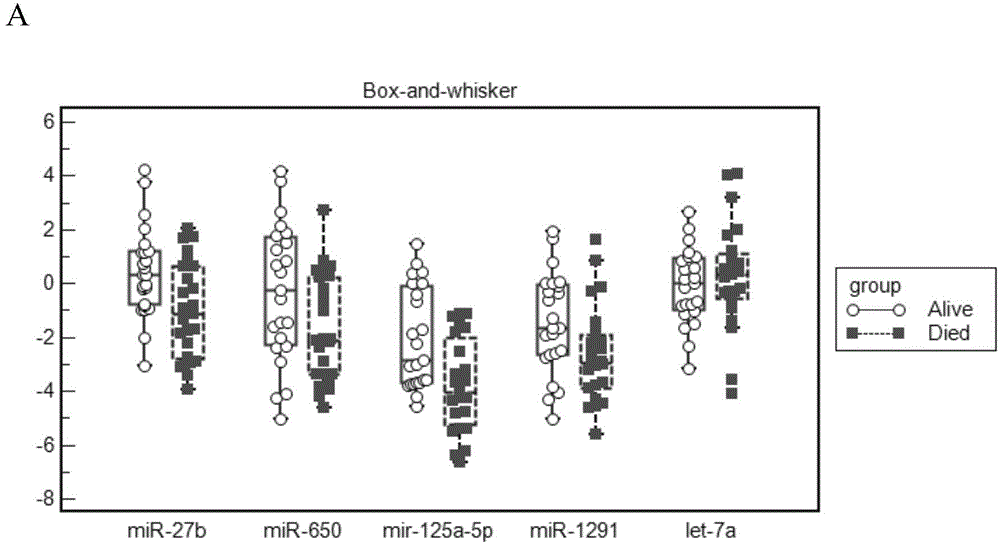Micro RNA biomarker for predicting early non-metastatic colorectal cancer prognosis and detection method
A colorectal cancer, non-metastatic technology, applied in the field of biomedicine, can solve the problems of unreported miRNA and miRNA differences
- Summary
- Abstract
- Description
- Claims
- Application Information
AI Technical Summary
Problems solved by technology
Method used
Image
Examples
Embodiment 1
[0151] Example 1: Patient Data
[0152] In the discovery experimental group, a total of 8 cases of large intestine paraffin tissue specimens archived in Huashan Hospital Affiliated to Fudan University in 2005 with five-year postoperative survival data were used. The patient's prognosis data came from the Shanghai Center for Disease Control. Among them, there were 4 cases of five-year survival after operation and four cases of death due to recurrence or metastasis of colorectal cancer within five years after operation. All participating patients had informed consent to the scientific research. All procedures for collecting specimens were approved by the Institutional Review Board of Shanghai Medical College.
[0153] In the verification experiment, a total of 56 colorectal cancer patients' paraffin tissue samples were used. The paraffin tissue samples of large intestine archived in Huashan Hospital Affiliated to Fudan University in 2005 were used. The patient's prognosis dat...
Embodiment 2
[0158] Embodiment 2: sample preparation
[0159] In discovery experiments, laser capture microdissection was optionally performed on each cancer sample to specifically isolate tumor cell populations (approximately 200,000 cells). Briefly, a clear transfer film is applied to the surface of a tissue section or sample. Under a microscope, thin tissue sections mounted on glass slides are viewed and cell populations are identified for isolation. When the selected cell is in the center of the observed field of view, a near IR laser diode integral with the microscope optics is activated. A pulsed laser beam activates spots on the transfer membrane, causing the membrane to fuse with the underlying selected cells. The transferred membrane with bound cells is then stripped from the thin tissue section (for review see e.g. Emmert-Buck, M.R. et al. (1996). Science 274, 998-1001; Espina, V. et al. (2007) Expert Rev. Mol. Diagn. 7, 647-657). Cryostat sections were prepared and a laser...
Embodiment 3
[0162] Example 3: chip data
[0163] In experiments, qualitative analysis of (differentially) expressed miRNAs in specific samples can optionally be performed using the Agilent miRNA microarray platform (Agilent Technologies, Santa Clara, CA, USA) according to the manufacturer's instructions. The chip contains 723 human microRNAs selected from Sanger database v.10.1. The amount of total RNA required for each sample was 100ng, and the Cy3 staining marker was incorporated. Chip scanning is through XDR Scan (PMT100, PMT5). The specific operation steps of labeling and hybridization are detailed in Agilent miRNA chip platform system. Raw data obtained for single-color (CY3) hybridization were normalized by applying the Quantile method and using GeneSpring GX10 software known in the art (Agilent Technologies, Santa Clara, CA, USA).
[0164] Unpaired t-test test was used to distinguish the statistical significance of differential expression of prognostic microRNAs in early non-m...
PUM
 Login to View More
Login to View More Abstract
Description
Claims
Application Information
 Login to View More
Login to View More - R&D
- Intellectual Property
- Life Sciences
- Materials
- Tech Scout
- Unparalleled Data Quality
- Higher Quality Content
- 60% Fewer Hallucinations
Browse by: Latest US Patents, China's latest patents, Technical Efficacy Thesaurus, Application Domain, Technology Topic, Popular Technical Reports.
© 2025 PatSnap. All rights reserved.Legal|Privacy policy|Modern Slavery Act Transparency Statement|Sitemap|About US| Contact US: help@patsnap.com



